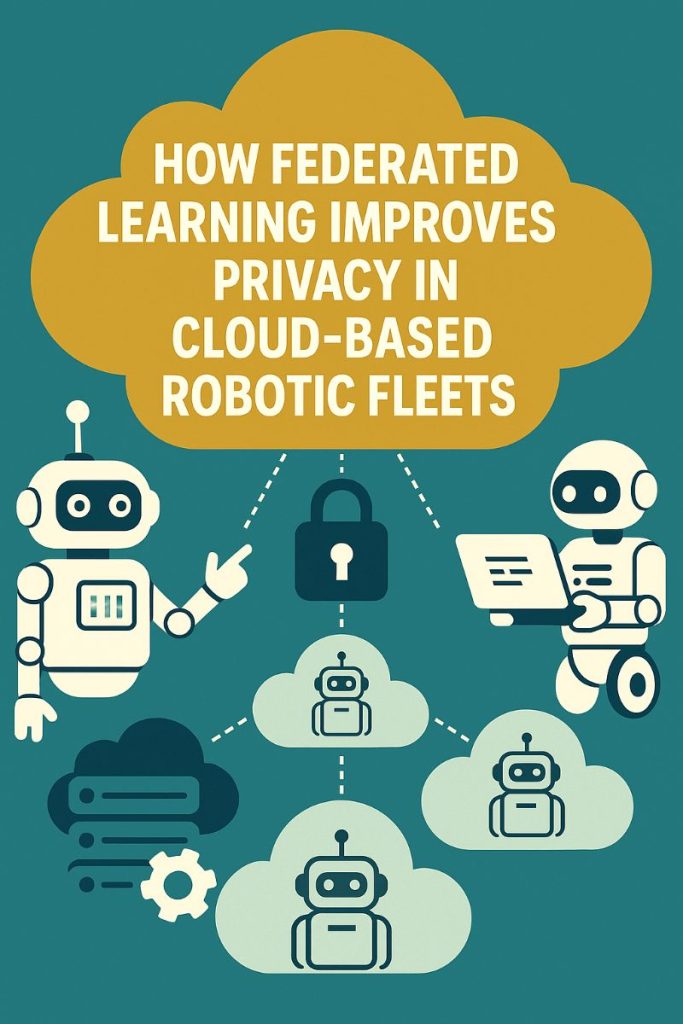Robots, privacy, and cloud tech walk into a bar… okay, not really. But let’s talk about how this weird trio is shaping the future of how machines learn without snooping into your business.
🧭 Table of Contents
What’s the deal with cloud-based robotic fleets?
Wait, what’s federated learning anyway?
Why privacy in robotic fleets is a big freakin’ deal
The magic trick: How federated learning keeps secrets safe
Real-world example: Robo-deliveries and grandma’s address
But like… is this foolproof? (Spoiler: nope)
Where federated learning meets the cool kids: AI, 6G, and neuromorphic chips
Link party: Dive deeper into related futuristic tech
Final thoughts: Trust the robots (sorta)
FAQ – Ask away
1. What’s the Deal with Cloud-Based Robotic Fleets?
Alright. So imagine you’ve got an army of delivery bots zipping around town, dropping off packages, pizza, dog food—whatever. These aren’t your regular Roombas. They’re hooked into a cloud system. Constantly learning, updating, syncing data like some cyberhive.
Pretty wild, right? But here’s the thing—every time one of these bots uploads data back to HQ (the cloud), there’s a chance someone could intercept it. And boom, you’ve got a privacy nightmare. Grandma’s house address? Not so private anymore.
2. Wait, What’s Federated Learning Anyway?
Okay, real talk: Federated learning is like group studying without ever leaving your room. Each robot (or phone, or device) trains a little on its own data, then sends only the learnings, not the actual data, back to the cloud. No raw footage. No private info.
Just the gist. Like, “Hey, I figured out potholes usually show up after rain,” without sending over the entire street cam footage of your driveway.
3. Why Privacy in Robotic Fleets is a Big Freakin’ Deal
Let’s be honest. Robots rolling around cities, mapping streets, recognizing faces, reading signs—there’s a ton of sensitive data flying around. You don’t want a robot accidentally livestreaming your backyard BBQ, do you?
Also, regulatory folks are watching. GDPR. HIPAA. All those fancy acronyms that basically say, “Don’t be creepy with data.” Federated learning helps you stay on the good side of these privacy guardians.
4. The Magic Trick: How Federated Learning Keeps Secrets Safe
Here’s the cool bit.
Data stays local. No raw data goes to the cloud.
Updates are shared in the form of model weights.
Encryption keeps it all safe in transit.
Even if someone hacks the cloud, they don’t get your sensitive info—just the model’s updated smarts.
It’s kinda like swapping test answers without showing your notes.
5. Real-World Example: Robo-Deliveries and Grandma’s Address
Let’s say your city’s using robot couriers (cute little guys on wheels). Every bot learns a bit about the best delivery paths. Instead of uploading footage of every doorstep (sketchy!), it uploads the insight: “Avoid Main St. at 5 PM.”
So, it knows your grandma lives on Elm Street, but it doesn’t broadcast it. That’s privacy. Federated learning style.
6. But Like… Is This Foolproof? (Spoiler: Nope)
Look, no system is perfect. If a hacker really wants in and gets access to multiple devices, they might be able to reverse-engineer something. But still, federated learning is miles better than central data collection.
Also, things get trickier when robots share environments—like swarm robotics. But that’s where things like blockchain and encryption protocols step in to save the day.
7. Where Federated Learning Meets the Cool Kids
You know what really cranks this up to 11?
Add 6G networks for lightning-fast data syncing.
Sprinkle in some neuromorphic hardware to mimic the human brain and save energy.
Mix with photonic computing for speed.
Use quantum algorithms to plan paths in real-time.
And yeah, let’s not forget multimodal AI that can see, hear, and feel all at once.
It’s a whole buffet of tech that works with federated learning to make robotic fleets smarter, safer, and… less creepy.
8. Link Party: Dive Deeper into Related Futuristic Tech
9. Final Thoughts: Trust the Robots (Sorta)
If we want robots in our cities, homes, and hospitals (and we kinda do), we have to talk privacy. Federated learning isn’t a silver bullet, but it’s a solid step in the right direction.
Let the bots learn. Just don’t let ‘em gossip.
10. FAQ – Ask Away
Q1: Is federated learning only used in robotics?
Nah, it’s used in phones too—like when your keyboard learns how you type without uploading your texts.
Q2: What kind of data are we talking about in robotic fleets?
Location, surroundings, voice commands, sometimes even facial recognition. Creepy if misused.
Q3: So, robots don’t share any data?
They share learnings—not raw data. Think insights, not screenshots.
Q4: What if the robot gets stolen?
Device encryption helps. Plus, updates are anonymized. So the thief’s getting junk, not juice.
Q5: Can federated learning be hacked?
Not easily, but nothing is bulletproof. Still way safer than centralized data.
Q6: Does this tech slow down the robots?
A tiny bit, maybe. But with stuff like 6G and edge computing? You won’t notice.
Q7: What about hospitals and robotic surgery?
Federated learning + 6G robotic surgery = privacy + speed. A lifesaving combo.
Q8: Is it expensive to implement?
Kinda. But prices are dropping fast as it scales.
Q9: Are there laws pushing this tech forward?
Yep. GDPR and other global privacy regulations encourage this kind of decentralized learning.
Q10: Should we be worried?
Only if we ignore it. Transparency + tech like federated learning = less to fear.

